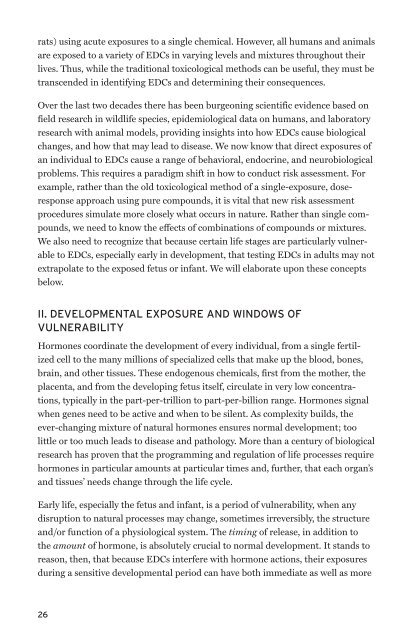Introduction to Endocrine Disrupting Chemicals
Introduction to Endocrine Disrupting Chemicals
Introduction to Endocrine Disrupting Chemicals
Create successful ePaper yourself
Turn your PDF publications into a flip-book with our unique Google optimized e-Paper software.
ats) using acute exposures <strong>to</strong> a single chemical. However, all humans and animals<br />
are exposed <strong>to</strong> a variety of EDCs in varying levels and mixtures throughout their<br />
lives. Thus, while the traditional <strong>to</strong>xicological methods can be useful, they must be<br />
transcended in identifying EDCs and determining their consequences.<br />
Over the last two decades there has been burgeoning scientific evidence based on<br />
field research in wildlife species, epidemiological data on humans, and labora<strong>to</strong>ry<br />
research with animal models, providing insights in<strong>to</strong> how EDCs cause biological<br />
changes, and how that may lead <strong>to</strong> disease. We now know that direct exposures of<br />
an individual <strong>to</strong> EDCs cause a range of behavioral, endocrine, and neurobiological<br />
problems. This requires a paradigm shift in how <strong>to</strong> conduct risk assessment. For<br />
example, rather than the old <strong>to</strong>xicological method of a single-exposure, doseresponse<br />
approach using pure compounds, it is vital that new risk assessment<br />
procedures simulate more closely what occurs in nature. Rather than single compounds,<br />
we need <strong>to</strong> know the effects of combinations of compounds or mixtures.<br />
We also need <strong>to</strong> recognize that because certain life stages are particularly vulnerable<br />
<strong>to</strong> EDCs, especially early in development, that testing EDCs in adults may not<br />
extrapolate <strong>to</strong> the exposed fetus or infant. We will elaborate upon these concepts<br />
below.<br />
II. DEVELOPMENTAL EXPOSURE AND WINDOWS OF<br />
VULNERABILITY<br />
Hormones coordinate the development of every individual, from a single fertilized<br />
cell <strong>to</strong> the many millions of specialized cells that make up the blood, bones,<br />
brain, and other tissues. These endogenous chemicals, first from the mother, the<br />
placenta, and from the developing fetus itself, circulate in very low concentrations,<br />
typically in the part-per-trillion <strong>to</strong> part-per-billion range. Hormones signal<br />
when genes need <strong>to</strong> be active and when <strong>to</strong> be silent. As complexity builds, the<br />
ever-changing mixture of natural hormones ensures normal development; <strong>to</strong>o<br />
little or <strong>to</strong>o much leads <strong>to</strong> disease and pathology. More than a century of biological<br />
research has proven that the programming and regulation of life processes require<br />
hormones in particular amounts at particular times and, further, that each organ’s<br />
and tissues’ needs change through the life cycle.<br />
Early life, especially the fetus and infant, is a period of vulnerability, when any<br />
disruption <strong>to</strong> natural processes may change, sometimes irreversibly, the structure<br />
and/or function of a physiological system. The timing of release, in addition <strong>to</strong><br />
the amount of hormone, is absolutely crucial <strong>to</strong> normal development. It stands <strong>to</strong><br />
reason, then, that because EDCs interfere with hormone actions, their exposures<br />
during a sensitive developmental period can have both immediate as well as more<br />
26















